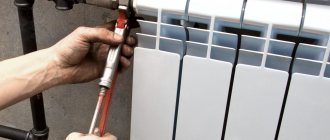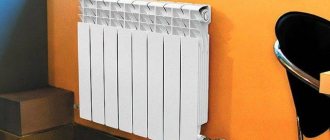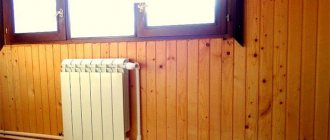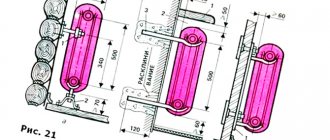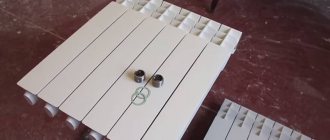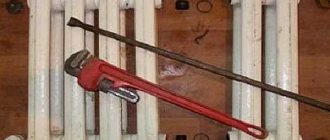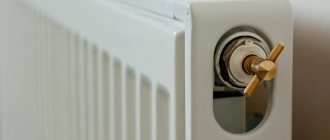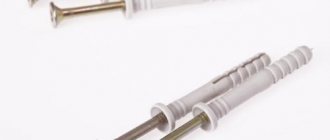How to flush a car heater radiator
Flushing the stove radiator video
The stove radiator can be washed either with or without removing it. In the latter case, usually cleaning compounds are simply poured into the radiator or driven by an additional pump connected to the pipes, and then washed with water.
Flushing the heater radiator without removing it
It’s easier to rinse the heater radiator without removing it. To do this, use one of three methods - using two plastic bottles, using a suspended large plastic bottle, or using an external water pump. The described methods allow you to create pressure in the radiator, under which cleaning liquid will circulate inside it.
Washing plastic bottles
Flushing the stove radiator using two plastic bottles
The method of washing with plastic bottles allows you to wash the radiator of the stove in two ways - in a removed state and directly in place from the engine compartment. To operate, you need the following tools: two one and a half liter plastic bottles, radiator cleaner, four clamps. The essence of the method is that the flushing liquid is poured halfway into the radiator and one bottle, alternately driven from one bottle to another by pressing on the bottles with hands or feet. In this way, its internal cavity is cleaned. The method is very simple and effective. When the liquid is very dirty, it needs to be replaced with clean one.
Another method is to cut off the bottom of a large plastic bottle (five to six liters), thus creating a watering can from it. And hang it higher, thus creating pressure for the liquid flowing out of it. Connect one hose to the neck and the first radiator pipe, and the second hose to the other radiator pipe and into a bucket on the floor. To ensure a tight seal, it is advisable to secure the hose to the radiator pipes using clamps.
When flowing out from a height, cleaning fluid under pressure will clean the internal cavity of the radiator. Continue working until the new fluid is sufficiently clean.
Flushing the radiator using a car pump
One of the most effective methods is to make a device based on an external liquid pump, which ensures constant circulation of detergent inside the stove radiator under pressure.
Flushing the heater radiator using a car pump. Photo taken from drive2.ru/users/ya-rusich
To make the device you will need: an electrically driven car pump, three hoses that match the diameter of the radiator and pump leads, a battery charger, an immersion boiler (which needs to heat the liquid), a solution container, a filter element (a synthetic sock or stocking), cleaning composition, a stand for a container with a solution at the pump level.
Connect the pump (inlet/outlet), the radiator (inlet/outlet pipes) and the basin containing the warm cleaning solution with hoses. Place a sock filter on the end of the outlet hose. Start the pump from the battery terminals so that it “drives” the liquid in a circle. And don't forget to connect the charger to the battery as it puts a lot of stress on it.
This will create a looped system through which the cleaner will circulate through the radiator. It is recommended to “drive” the liquid for an hour in one direction and an hour in the other direction. Then replace the fluid with clean one and repeat the procedure again. When finished, rinse the radiator with boiled or distilled water for half an hour in each direction.
All the described methods can also be used if the stove radiator is removed from its seat. This will allow you not only to clean it under pressure, but also simply by pouring special cleaning agents into it. In addition, an additional advantage of dismantling is that the car owner will have the opportunity to remove debris and also inspect it for damage and corrosion.
Battery cleaning brushes and sponges
To remove old stains, the following will help:
- A toothbrush, brush or narrow paint brush with stiff bristles. They are able to crawl into the most remote corners of the radiator.
- Sponge. If you attach it to a long ruler, it can also clean hard-to-reach places.
- Rubber glove. You need to put it on your hand and wash it well with laundry soap. Then rub off stubborn stains on the heater using your fingers. Can be replaced with old cut-off tights or socks.
- Dishwashing brush. Use this brush to clean the battery. They are sold in hardware stores and have a comfortable long handle.
- Spray. In order to wash the inside of old batteries, you need to add detergent to the spray bottle and spray the dirt. Wait a while and wipe the soaked areas with a damp cloth.
Before using cleaning chemicals, you should carefully read the composition. Since it may contain aggressive active substances that can easily destroy the surface of the radiator.
How to flush a car heater radiator
On modern cars, heater radiators are made of two main materials - copper and aluminum. For aluminum radiators you need to use acidic agents, and for copper radiators - alkaline compounds. You cannot use alkaline solutions to clean aluminum radiators, as its surface will immediately begin to oxidize, and the clogging situation will only worsen or even ruin the part!
List of products that can be used for washing aluminum and copper stove radiators.
| Means | Radiator type | The need to dismantle the radiator when flushing | |
| Aluminum | Copper | ||
| Lemon acid | ✓ | ✓ | × |
| Table vinegar | ✓ | ✓ | × |
| Lactic acid or whey | ✓ | ✓ | × |
| Battery electrolyte | ✓ | ✓ | ✓ |
| Caustic soda | × | ✓ | ✓ |
| Orthophosphoric acid | ✓ | ✓ | ✓ |
| Boiled or distilled water | ✓ | ✓ | × |
| Special professional products | ✓ | ✓ | × |
Flushing the stove radiator with citric acid
Using citric acid, you can clean radiators made of any metal, both aluminum and copper. There can also be several proportions and recipes for its use. One of them is to take 20...40 grams of dry acid and dissolve them in one liter of water. If the radiator is heavily clogged, the amount can be increased to 80...100 grams per liter (increase the volume of the flushing mixture proportionally). Ideally, the acid solution should be checked using litmus paper - the pH value should be 3 . This is the optimal composition for cleaning the stove radiator.
The acid solution can be used according to the methods described above, pouring it inside. An alternative is to pour it into the car instead of antifreeze, and start the engine for 30...40 minutes, let it idle or take it for a drive, and then leave it overnight. Then drain the liquid; if it is very dirty (with a lot of sediment), the procedure should be repeated one or two more times. After this, rinse the cooling system with ordinary distilled water and add new antifreeze.
Washing with vinegar
Acetic acid is another affordable and effective means for cleaning both the cooling system in general and the stove radiator in particular. To prepare the washing solution, you will need 500 ml of table vinegar, which must be diluted in 10 liters of boiled or distilled water. Otherwise, you can proceed by analogy with washing with citric acid. This composition is suitable for radiators made of both copper and aluminum.
Serum wash
Flushing the stove radiator with serum
The lactic acid present in the serum perfectly washes plaque, rust, and debris from the walls of both aluminum and copper radiators. However, it is quite difficult to find lactic acid in its pure form, so the easiest way is to use natural (this is very important!!!) whey.
To clean the stove radiator you need 5...10 liters. Before use, you need to strain the whey through a filter a couple of times in order to remove any pieces of fat from it!
Most often, it is poured into the system and rolled for about half an hour, and then drained and the system is washed with hot distilled water several times, since the whey contains fat.
Flushing the stove radiator with electrolyte
Battery electrolyte also removes various deposits and deposits well. Almost any electrolyte can be used in sufficient quantities. It can be used to clean both copper and aluminum radiators (but not for very long!). When working with electrolyte, be sure to wear work clothes, rubber gloves, a respirator and safety glasses.
After removing the radiator, fill it with electrolyte and leave it for a couple of hours so that a chemical reaction occurs, during which the dirt and plaque will dissolve. Then drain and wash. Only the first time the water used should be with a small amount of baking soda (1 tablespoon per liter). And then it is advisable to use a cyclic “run” of water through the insides of the radiator.
Washing with caustic soda
Caustic soda is a caustic alkali, it can have several names, caustic soda, sodium hydroxide, caustic. used to clean aluminum radiators, only copper ones and even after removing them from the car , because it has a detrimental effect on the aluminum parts of the cooling system.
And to clean the radiator, use a 10% solution of caustic soda. When making it, personal protective equipment is needed, because if it gets on the skin, caustic can cause a chemical burn. Before use, the resulting solution must be heated, then poured and left for several hours, then drained. If necessary, repeat the procedure two or three times until the liquid being poured out is relatively clean. When finished, be sure to rinse the radiator with clean boiled or distilled water.
How to rinse with phosphoric acid
Phosphoric acid, or rather its 85% solution, sold in specialized stores, is also well suited for cleaning aluminum and copper heater radiators. It is used on radiators removed from cars. You need to work in personal protective equipment, gloves, and a respirator.
You just need to pour the acid inside the radiator and leave it there for a couple of hours. After this, rinse thoroughly with boiled or distilled water. It does not corrode the metal, but instead dissolves the plaque and rust that has formed inside.
Washing with water
The simplest, but most ineffective remedy is ordinary boiled (this is important!!!) or distilled water. However, if you just want to rinse the radiator with water, you need to do this under pressure. As a rule, it is not used in its pure form, but only as a rinse after some kind of product.
Special means for flushing the stove radiator
For those who do not trust traditional “old-fashioned methods,” auto chemical manufacturers have made ready-made products that are specifically designed for cleaning the car’s cooling system.
Popular product LIQUI MOLY Kuhler-Reiniger
- LAVR Radiator Flush Classic . Can be used to flush radiators made of both aluminum and copper. Sold in cans of 430 ml and 980 ml. A small can is designed for a cooling system volume of 8…10 liters. Therefore, its quantity must be calculated in accordance with the volume of the radiator. Instructions are on the package. It is noted that the product perfectly removes rust, limescale, dirt and other debris. The price of one small can as of summer 2022 is about 400 rubles.
- LIQUI MOLY Kuhler-Reiniger . The product is also intended for cleaning the cooling system. Can be used to clean radiators made of any metal. Removes rust, plaque and debris well. sold in a 300 ml metal can, which is designed for a 10 liter cooling system. Costs about 625 rubles.
- Hi-Gear Radiator Flush . A distinctive feature of washing is that it cleans within seven minutes. Can be used to clean any radiators made of aluminum or copper. One 325 ml can holds 17 liters. The price is about 290 rubles.
Please note that old radiators may leak after flushing, since debris accumulated inside could simply seal the housing. Therefore, after washing with special means, it is necessary to rinse the radiator from the inside with water and carefully examine it for leaks at the seams.
Flushing the engine cooling system.
Antifreezes generally have a service life of 5 years or until the engine travels 250 thousand km. Antifreeze has a service life of 2-3 years. By the way, you can see what happens if you mix antifreeze with antifreeze. Depending on the operation of the vehicle and the quality of the coolant, if the coolant is not changed or if the coolant is diluted, the radiator channels and cooling jacket become clogged. Therefore, to increase the overhaul life of the engine, it is necessary to periodically flush the engine cooling system. You can wash it both in car services and at home in your own garage.
Many drivers clean the cooling system with their own hands. Some use citric acid, some use Coca-Cola, some use diesel fuel, some use special equipment (eg Laurel), some use something else.
Anyone who wants to avoid problems with the engine must flush the cooling system regularly at certain intervals. During engine operation, deposits, rust, oil deposits, sediment and scale accumulate on the walls of the radiator and pipes. There will be much more clogging substances if the engine was running at high speed, the temperature almost reached the red mark.
If the radiator channels and pipes are clogged, then circulation will deteriorate accordingly. And poor engine circulation will create additional problems: the engine will overheat (which may cause the cylinder head to be removed to replace the gasket), cool air will blow from the stove, and engine parts are subject to increased wear.
It is advisable to flush the car's cooling system once a year. To change the coolant you need warm weather.
There is a cooling radiator icon on the instrument panel, which, if lit, indicates either a low level of antifreeze or antifreeze, or that the radiator needs to be cleaned or replaced. This icon is found on some car brands.
A list of cars, how many liters of antifreeze in the cooling system we looked at in another article. It shows the brands and models of cars and the required coolant volumes for them.
Outside
How to rinse cast iron radiators, as well as all others? You can clean up the outside of the radiator using several methods - it all depends on the degree of contamination.
Dry cleansing
Everything we cover here is more suitable for everyday cleaning. For general purposes, more serious methods are needed. So, there are two simple and effective ways:
- Using a vacuum cleaner. It’s very good if you have special attachments - because the battery sections are sometimes very close to each other, so you can’t get to them with a regular floor brush.
- Using a hair dryer. In this case, a damp cloth of suitable size is attached between the wall and the radiator. Air from the device simply blows dust between the battery sections onto this cloth. Then it remains to carefully remove the material and rinse it from dust.
Wet cleansing
How to clean a heating battery when it is very dirty? If you want to do high-quality spring cleaning, then this is the place for you. First of all, we focus on the degree of contamination of the radiator:
Light to medium soiling. Before wet cleaning, it is best to carry out dry cleaning, which we described above. It is advisable to use hot water, even boiling water. Be sure to find a container of suitable size that can be placed under the entire duration of the battery - water will flow into it
Then, from another container, carefully pour boiling water over the battery, section by section. After the water has drained from it, it is additionally dried with prepared rags, napkins
Washing areas between sections. To ensure that wet cleaning reaches areas between sections that we physically cannot reach with our hands, it is best to use a steam mop (pictured). Some housewives additionally spread cotton napkins for better steam absorption. As an option, you can wrap a rag around a pointer, a stick, a narrow handle, or a nozzle for something and, moistening it in water, clean hard-to-reach areas.
Heavy contamination. Anti-fat agents are used. An aqueous solution is first prepared from them, which is poured into a spray bottle or spray bottle and thoroughly sprayed over a moistened battery. Then some time is given to “acidify”. After which the cleaning solution is completely removed with water and rags from the surface of the battery.
For what?
Let's decide why we need to spend time and effort cleaning the radiator. Flushing is necessary in the following cases:
- During a tactile examination, you determined that the battery is heating unevenly - one part is colder than the other.
- Compared to other seasons, your apartment has warmed up an order of magnitude slower (especially if your neighbors don’t notice this in their homes).
- The heating main is hotter than the radiators.
- For private houses, energy resources for heating have increased, but heat transfer has remained the same or even decreased.
The bimetallic radiator takes the lead today.
Thus, without cleaning, your house will become colder and colder every season, taking into account the fact that you will pay the same money for heating.
Processing technique
Outside
External treatment of heating radiators is a fairly simple and easy task. In principle, to maintain the system in proper condition, it is enough to go over each radiator with a vacuum cleaner during the cleaning process, and then treat the surface with a damp cloth and a non-aggressive detergent.
However, if there are difficulties with cleaning or you need to restore the working condition of a fairly old heating device, then we proceed in this way:
- If the design of the device provides for this possibility, we dismantle the protective screens, case walls and grilles in the upper and lower parts of the product. As a rule, this is where the bulk of dust accumulates.
Removing dust with a brush
- We clean these parts under running water, using a sponge or scraper if necessary. After cleaning, dry them thoroughly.
- We treat the radiator itself with a vacuum cleaner, removing large accumulations of dust with a brush.
- We wipe all surfaces with a damp sponge, trying not to leave streaks.
Advice! When cleaning copper pipes and heat exchangers, it is not advisable to remove the patina as it protects the metal surface from further oxidation and corrosion.
Cleaning sections with a sponge
In principle, nothing more is required: the main thing is not to let the situation get worse until a dense dust “felt” forms between the heat exchange plates.
From the inside
However, tidying up the outside of the battery is not even half the battle. Internal cleaning is much more difficult. Most often, to solve this problem, they involve specialists with rather complex equipment, or they flush the entire heating system of the house at one time, but if you wish, you can do it yourself.
Flushing the heating system using a special pump
You need to act this way:
- We close the valves, blocking the flow of coolant to the radiator.
- We unscrew the nuts that connect the battery to the heating network pipes.
- Carefully drain the remaining water from the tanks.
- We remove the battery from its mounts and take it out of the room, since internal cleaning is almost always accompanied by the appearance of a large amount of dirt.
Advice! If you live in a private house, then it is better to carry out all activities on the street, near the drainage pit. In an apartment, you will have to use a bathroom, covering it with thick fabric to avoid damage to the enamel and installing a protective mesh on the drain hole to catch solid particles.
Hose Flushing Procedure
The cleaning itself is carried out as follows:
- We take a mallet (it can be replaced with a regular hammer and a wooden block) and carefully tap all sections of the radiator. This effect will accelerate the detachment of plaque and rust from the walls.
- We tilt the radiator on its side, shake it thoroughly and pour large solid particles out of the drain hole.
- Then pour hot water into the radiator tanks and let it sit for about 20-30 minutes.
- After this, use a shower or hose to rinse, treating the internal surfaces until clean water comes out of the drain hole.
Cleaning methods
To flush heating radiators, four methods are used that do not require dismantling the radiators. They can be used during the heating season.
Chemical method
It is the most popular cleaning method due to its simplicity and minimal cost. This method is not suitable for cleaning aluminum radiators. When cleaning, organic and inorganic acids and various alkaline compounds are used, which are placed in a special container with a pump.
The cleaning solution is poured into the heating system for a certain time, depending on the degree of contamination.
Prices for solutions for flushing heating systems
Hydrodynamic method
To carry out hydrodynamic washing, you will need special equipment, this is a high-pressure hydrodynamic jet machine. Before flushing, the coolant is completely drained from the system. Next, place a device hose with a special nozzle in place of one of the dismantled pipes. In this way, deposits are removed using a thin jet of water under high pressure. At the end of the procedure, water is passed through the system several times to remove any remaining dirt.
